The word Genetics was coined by an English biologist William Bateson in 1905 [regarded as Father of Modern Genetics]. The word Genetics is derived from a greek word ‘gen’ meaning to become or to grow into. Genetics is the branch of biology which deals with the study of heredity and variation.
Heredity: Transmission of characters from one generation to another generation is called heredity.
For example, human babies are like human beings in over all characteristics. This has been summed up in the phrase ‘like begets like’.
Variation: The tendency through which the organisms differ in specific ways from one-another is called variation. e.g. we can easily distinguish the members of a family, except the identical twins.
Also Check: Human Health
Mendelism
Gregor Johann Mendel: Mendel was born on 22 July 1822 at Heinzendorf in Austria.
Mendel worked in Augustinian Monastry in Brunn, as monk.
In 1856–57, he started his historical experiments of heredity on garden pea plant. [Pisum sativum]. His experimental work continued on pea plant till 1865.
The results of his experiments were published in the science Journal ‘Natural History Society of Brunn’ in 1866 entitled “Experiments on plant Hybridization”.
Mendel died on January 6, 1884, due to kidney disorder
Mendel’s work remain unnoticed and unappreciated for some 34-35 years due to :–
- His work was ahead of his time.
- He published it in a journal that had limited circulation.
- He was himself not sure of his findings, as he failed to get similar results on hawkweed(Hieracium).
- Mind of the biologists was pre–occupied with the Darwin’s theory of evolution.
Rediscovery of Mendel’s Work (the birth of Genetics)
It was in 1900 that three botanist independently rediscovered the principles of heredity already worked out by Mendel. They were :–
- Karl Correns – Germany – Worked on maize (Zea mays)
- Hugo de Vries – Holland – Worked on evening primrose (Oenothera).
- Erich von Tschermak – Austria – Worked on flowering plants.
Correns gave the two law of Mendelism – law of segregation and law of independent assortment.
Hugo de Vries also found out the paper of Mendel and got it published in “Flora” in 1901.
Bateson, Punnet and other subsequent workers found Mendel’s work to be of universal application including animals.
Genetic Terminology
Gene: Mendel used the term factor for a gene. A gene is the unit of DNA responsible for the appearance and inheritance of character.
Allelomorph or Allele: Is a Greek word which means belonging to one another. It refers to one of the two members of a gene pair.
Allelomorphs or Alleles are a pair of genes that control the two alternatives of the same character and located at the same locus in the homologous chromosomes.
Gene Locus: It is the region on chromosome representing a single gene. The alleles of a gene are present on the same gene locus on the chromosome.
Heterozygous: The prefix hetero means ‘different’ and zygous means ‘a pair’. The organism in which both the genes of a character are unlike is said to be heterozygous or hybrid. Such organisms do not breed true on self fertilization eg. Tt.
Homozygous: The prefix homo means ‘the same’ and zygous means ‘a pair’.The organism in which both the genes of a character is said to be homozygous or genetically pure for that character. It gives rise to offsprings having the same character on self breeding. e.g TT or tt.
Dominant and Recessive: A heterozygote possesses two contrasting genes or alleles but only one of the two is able to express itself, while the other remains hidden. The gene which gains expression in F1 hybrid is known as dominant gene while its allele is unable to express itself in presence of the dominant gene is recessive gene.
Genotype (Johanssen): Genotype of an individual refers to the sum total of genes inherited from both the parents irrespective of whether they are expressed or not.
OR
It is the genetic constitution of an organism which determines the characters.
Phenotype (Johanssen): It is the appearance of an individual.
OR
Phenotype of an individual refers to the expressed or observable structural and fuctional traits produced by interaction of genes and environment.
Pureline: Generations of homozygous which produce offsprings of only one type i.e. they breed true for their phenotype and genotype. For example, tall pea plants when produce only tall plants, generation after generation on being self pollinated or cross pollinated among themselves.
Genome: Total set of genes in the haploid set of chromosomes and inherited as unit from parents to offspring.
Genepool: All the genotypes of all organisms in a population form the gene pool.
Mendel’s Experimental Plant
Mendel selected common garden pea (Pisum sativum) for his experiments, because the plant shows the presence of several contrasting traits. But it was useful in his experiments also because:
- The pea is small and annual plant. Duration of life cycle is about 2–3 months only. A large number of offsprings can be analysed within short duration.
- It has many contrasting traits.
- Self pollination is found naturally in pea plant because flowers are cleistogamous.
- Cross pollination is possible artificially.
- Pea plant is easy to cultivate.
Detailed investigations by Stig Blixt on pea plant led to the location of Mendel’s seven selected characters on 4 different chromosomes i.e 1, 4, 5 and 7.
Experiments of Mendel
Selection of parents: Mendel selected 7 pairs of pure or true breeding varieties as the starting material for his experiments. On self pollination or self breeding, a pure variety gives rise to offspring having similar trait. e.g., tall variety with tall offspring, a purple flowered variety with purple flowered offspring, etc. Mendel employed seven traits of characters for his experimentation, one from each variety.
Hybridisation for F1 Generation: Mendel performed reciprocal crosses between plants having alternate forms of a trait, tall and dwarf, red flowered and white flowered. In reciprocal crosses pollen of one form were dusted over the stigma of the other form and vice versa, e.g., pollen from flowers of tall plants to emasculated flowers of dwarf plants and pollen from flowers of dwarf plants to emasculated flowers of tall plants. The hand pollinated flowers were covered with paper bags in order to avoid contamination from foreign pollen. The cross in which only two alternate forms of a single trait or character are taken into consideration is called monohybrid cross. Mendel also performed crosses involving two characters. They are called dihybrid crosses. Trihybrid and polyhybrid crosses were performed as well.
The seeds of the cross or crosses were collected and sown next year. The hybrid offspring including the seeds constitute the next generation termed first filial or F1 generation.
Monohybrid Cross: When only a single pair of contrasting or differentiating characters is considered in a cross (or inheritance of only one pair of contrasting characters is studied in a cross), it is called monohybrid cross, e.g ; Phenotypic ratio in F2 gen. of monohybrid cross=3: 1
(Tall)(Dwarf): Genotypic ratio in F2 gen. of monohybrid cross = 1: 2 : 1
(Pure tall)(Hybrid tall) (Dwarf): The two forms of the trait appear in F2 generation in ratio of three dominant to one recessive, 3 : 1. It is also called monohybrid ratio. For example, in the character of height (cross tall X dwarf) Mendel obtained 787 tall and 277 dwarf plants (ratio 2.84 : 1). A similar result for flower colour was 705 violet to 224 white (ratio 3.15 : 1).
Reciprocal Cross: Similar results were obtained with reciprocal crosses also. A reciprocal crosses involves the same traits but carried by sexes opposite to those in the original or first cross.
Back Cross: When F1 individual (Tt) is crossed with one of the two parents, either tall (TT) or dwarf (tt), such a cross is called the back cross. There are two possibilities in such a cross:
- When F1 (Tt) is crossed with the dominant homozygous (TT) parent, the plants produce will be 100% tall.
- If F1 (Tt) is crossed with recessive homozygous (tt), 50% plants will be tall and 50% dwarf.
Uses of a Back Cross: Back crosses are used by plant breeders to rapidly improve a variety by making a useful trait (gene) homozygous, that is pure.
Test Cross: Crossing of F1 hybrid with its homozygous recessive parent is called test cross and the progeny of test cross is called test cross progeny.
- Monohybrid Test Cross: Thus monohybrid test cross ratio = 1 : 1
Uses of a Test Cross: The test cross reveals the genotype of an organism displaying the dominant phenotype, hence its name.
Results of Monohybrid Crosses
Mendel got the following results from his monohybrid crosses:
- F1 plants produced by a cross between two plants pure for the contrasting traits of a character are similar and express only one contrasting trait, i.e; resemble only one parent. None is intermediate between the two alternative traits of parents.
- It does not matter which parent provides male gamete and which provides female gamete, the results remain the same. In other words, the reciprocal crosses produce similar F1 plants.
- Both the contrasting traits appear in the F2 plant.
- The contrasting trait of a character expressed in F1 plants appears in three–fourths of the F2 plants.
- One of the two contrasting traits of a character remains unexpressed (hidden) in F1 generation.
Conclusions Drawn from the Monohybrid Crosses
From the results of his monohybrid crosses, Mendel found out the following conclusions:–
Principle of Unit or Paired Factors (Postulate 1): A character is represented in an organism (diploid) by at least two factors. The two factors lie on the two homologous chromosomes at the same locus. They may represent the same (homologous, e.g; TT in case of pure tall Pea plants) or alternate expression (heterozygous, e.g; Tt in case of hybrid tall Pea plants) of the same character. Factors representing the alternate or same form of a character are called alleles or allelomorphs.
Principle of Dominance (Postulate 2): It states, “When a pair of alleles or allelomorphs are brought together in F1 hybrid, then only one of them expresses itself, masking the expression of other completely.” e.g; In Tt–F1 hybrid is tall Only ‘T’ expresses itself – so dominant and ‘t’ is masked – so recessive.
Principle of Segregation or Principle of Purity of Gametes (Postulate 3): It states that, “When a pair of alleles or allelomorphs are brought together in F1 hybrid, they remain together (coexist) without mixing or contaminating or blending with each other and separate complete and pure during formation of gamete (gametogenesis).”
It is also known as ‘Law of purity of gametes’ because each gamete is pure in itself, i.e; having either T (i.e; gene for tallness) or t (i.e; gene for dwarfness).
Epistasis
- Epistasis was first studied by Bateson.
- Epistasis (Gk. act of stopping) is the phenomenon of suppression of phenotypic expression of a gene by a non allelic gene (present at separate loci) which shows its own effect. The gene which masks the effect of another is called epistatic gene while the one which is suppressed is termed hypostatic gene.
- Epistasis is similar to dominance but the two factors occupy two different loci. The epistasis involves intergenic suppression, while dominance involves intragenic suppression.
- Epistasis may be caused by the presence of homozygous recessives at one gene pair or by the presence of a dominant allele at a gene pair. In addition the epistatic effect may be in only one direction or in both directions.
- It is of mainly two types : dominant epistasis and recessive epistasis.
DOMINANT EPISTASIS (12:3:1 RATIO): A dominant epistatic allele suppresses the expression of a nonallelic gene whether the latter is dominant or recessive.
Example:In summer squash (Cucurbita pepo), there are three common fruit colours, white, yellow and green. White is dominant over both yellow and green but yellow is dominant over green only. There is a factor for white (W) which is epistatic to those for yellow and green. As long as it is present, no colour is produced in the fruit. If factor W is lacking and factor for yellow (Y) is present, the fruit colour is yellow. The fruit colour is green if both the factors W and Y are absent. Plant with white fruit (WWYY) crossed to plant with green fruit (wwyy), only plant with white fruit (Ww Yy) is produced in F1. On selflng, F2 gives rise to plants with white, yellow and green fruits in 12:3:1 ratio.
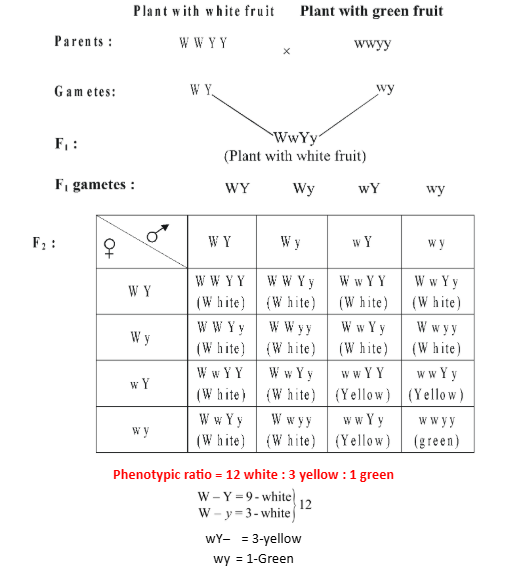
Phenotypic ratio = 12 white : 3 yellow : 1 green
wY–= 3-yellow
wy= 1-Green
RECESSIVE EPISTASIS (9 : 3 : 4 RATIO): Epistatic gene suppresses the expression of nonallelic gene only when it (epistatic) is in homozygous recessive state.
Example: Coat colour in mice: In mice, the wild body colour is known as agouti. The agouti colour is controlled by a gene, say A, which is hypostatic to recessive allele ‘C’. The dominant allele C in the absence of A gives black mice. Moreover, in the presence of dominant allele C, A gives rise to agouti. Therefore, CCaa will be black and ccAA will be albino. Here, cc masks the effect of AA and is, therefore, epistatic. Consequenty, ccAA is albino. However, ccaa is also albino, but not due to epistatsis but due to the absence of both the dominant alleles.
Black mice (CCaa) crossed with albino mice (ccAA) produced agouti mouse (CcAa) in F1. On selfing, in F2 agouti mice, black mice and albino mice are produced in a ratio of 9:3:4.
Phenotypic ratio = 9 agouti : 3 black : 4 albino
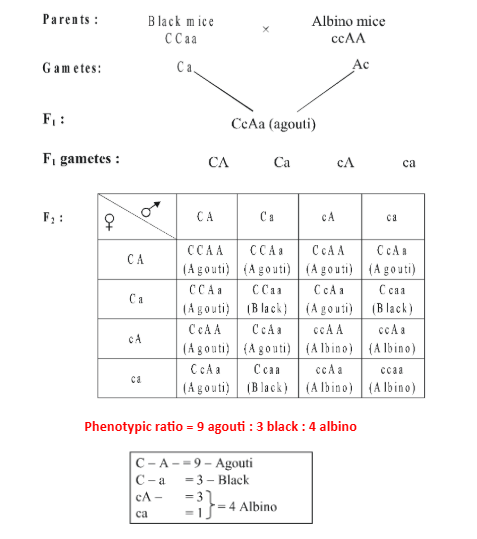
DUPLICATE GENES (15:1 RATIO): When two pairs of genes located on different chromosomes determine the same phenotype then they are called duplicate genes.
15 Triangular : 1 Ovoid-Oblong
Fig.:Inheritance of capsule shape in Capsella indicating the action of duplicate genes.
Polymeric or Additive Genes
(Duplicate genes with Cumulative Effect): Two independent dominant genes, whether present in homozygous or heterozygous condition, have similar phenotypic effect when present individually but produce a cumulative or double effect when found together. The effect is produced in 9/16 of the population. 6/16 population forms simple dominant trait as phenotypes produced by single gene dominance of the two different genes are similar. Therefore, a dihybrid ratio of 9 : 6 : 1 is obtained in the F2 generation.
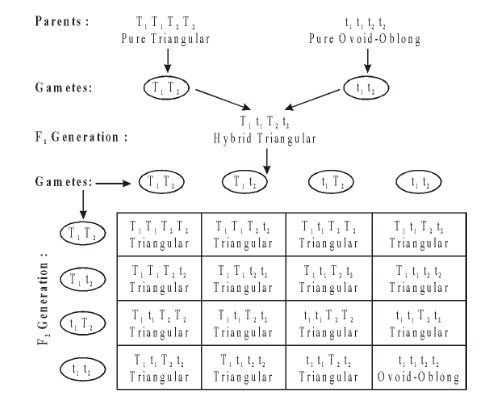
Fruits Shape in Summer Squash
Cucurbita pepo (Summer Squash) has three types of fruit forms—disc-shaped, spherical and long. Spherical shape is dominant over long shape. The shape is produced individually by one of the two dominant genes, S1 (– S1s2s2) and S2 (s1s1S2–). When both the dominant genes are brought together (–S1S2–), disc-shaped fruits are formed indicating that the two independent genes are acting in additive or cumulative fashion. This is observed by self pollinating the F1 hybrids having disc-shaped fruits. F2 generation has a ratio of 9 discoid, 6 spherical and 1 long.
9 Disc : 6 spherical : 1 Long
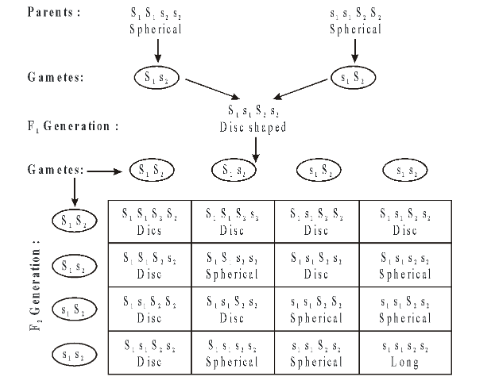
Fig.:Inheritance of capsule shape in Capsella indicating the action of duplicate genes.
Quantitative (Polygenic) Inheritance
Sometimes a single character is controlled by more than one genes, each having two allelic forms. Such traits are called polygenic traits. The effect of these genes on a particular trait is cumulative or quantitative. Thus, one gene will produce some effect, two genes will produce greater effect and the combined effect of all concerned genes for that trait will be greatest.
The genes involved in quantitative inheritance are called polygenes. Quantitative inheritance is, therefore, also called polygenic inheritance or multiple factor inheritance. Quantitative or polygenic inheritance was first studied by J. Kolreuter (1760) in case of tobacco, F. Galton (1883) in case of human beings and E. M. East (1916) in case of corolla length in Nicotiana longiflora. Nilsson-Ehle (1908) obtained the first experimental proof of polygenic inheritance in case of kernel colour in wheat.
Polygenic inheritance can be known from the frequency distribution of phenotypes. In monogenic or qualitative inheritance the phenotypes are two (3 : 1) in case of single gene pair and 4 (9 : 3 : 3 : 1) in case of two pairs of genes. In polygenic or quantitative inheritance the number of phenotypes is 3 (1 : 2 : 1) in case of one polygene pair, 5
(1: 4 : 6 : 4 : 1) in case of two polygene pairs and 7(1: 6 : 15 : 20 : 15 : 6: 1) when three polygene pairs are involved. Thus, we see that the number of intermediate types increases with the increase in the number of polygenes but the number of parental types remains the same (2 in the above cases).
The possible origin of polygenes is
- Duplication of chromosome part
- Polyploidy or increase in chromosome number
- Mutations producing genes having similar effect.
The most interesting example of polygenic inheritance is the skin colour in man (studied by
C.B. Davenport, 1913). Human skin colour is controlled by three separate genes, A, B and C. Each gene contributes to a unit of darkness. The black or very dark colour (Zet black/Negroes) is due to AABBCC and caucassian/very light/white is due to aabbcc.
A marriage between the two yields intermediate or mulatto (AaBbCc) offsprings. When such heterozygous individuals intermarry among themselves, 8 possible gametic combinations and 64 zygotic combinations (27 genotypes) will be expected (7 phenotypic combination). These individuals are expected to show all the shades of skin colour depending upon the fact whether they have only A, AB or ABC.
Create a simple and organized HTML code of the given pdf, Write in detail and write each and every words
Back Cross
When F1 individual (Tt) is crossed with one of the two parents, either tall (TT) or dwarf (tt), such a cross is called the back cross. There are two possibilities in such a cross:
- (i) When F1(Tt) is crossed with the dominant homozygous (TT) parent, the plants produce will be 100% tall.
- (ii) If F1(Tt) is crossed with recessive homozygous (tt), 50% plants will be tall and 50% dwarf.
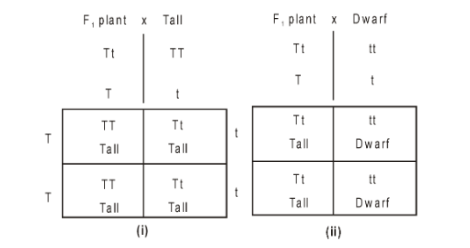
Tt × TT Tt × tt
T t T t
TT Tt Tt tt
Tall Tall Tall Dwarf
TT Tt Tt tt
Tall Tall Tall Dwarf
(i) (ii)
Uses of a Back Cross: Back crosses are used by plant breeders to rapidly improve a variety by making a useful trait (gene) homozygous, that is pure.
Test Cross
Crossing of F1 hybrid with its homozygous recessive parent is called test cross and the progeny of test cross is called test cross progeny.
A. Monohybrid Test Cross
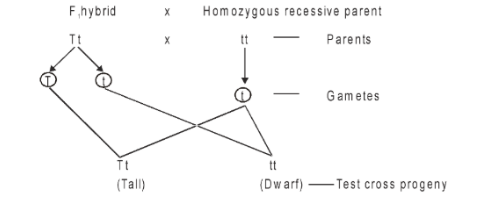
Tt × tt → Parents
T t ← Gametes
Tt tt
(Tall) (Dwarf) ← Test cross progeny
Uses of a Test Cross: The test cross reveals the genotype of an organism displaying the dominant phenotype, hence its name.
Results of Monohybrid Crosses
Mendel got the following results from his monohybrid crosses:
- F1 plants produced by a cross between two plants pure for the contrasting traits of a character are similar and express only one contrasting trait, i.e; resemble only one parent. None is intermediate between the two alternative traits of parents.
- It does not matter which parent provides male gamete and which provides female gamete, the results remain the same. In other words, the reciprocal crosses produce similar F1 plants.
- Both the contrasting traits appear in the F2 plant.
- The contrasting trait of a character expressed in F1 plants appears in three–fourths of the F2 plants.
- One of the two contrasting traits of a character remains unexpressed (hidden) in F1 generation.
Conclusions Drawn from the Monohybrid Crosses
From the results of his monohybrid crosses, Mendel found out the following conclusions:
Principle of Unit or Paired Factors (Postulate 1):: A character is represented in an organism (diploid) by at least two factors. The two factors lie on the two homologous chromosomes at the same locus. They may represent the same (homologous, e.g; TT in case of pure tall Pea plants) or alternate expression (heterozygous, e.g; Tt in case of hybrid tall Pea plants) of the same character. Factors representing the alternate or same form of a character are called alleles or allelomorphs.
Principle of Dominance (Postulate 2): It states, "When a pair of alleles or allelomorphs are brought together in F1 hybrid, then only one of them expresses itself, masking the expression of other completely." e.g; In Tt–F1 hybrid is tall
Only 'T' expresses itself – so dominant and 't' is masked – so recessive.
Principle of Segregation or Principle of Purity of Gametes (Postulate 3): It states that, "When a pair of alleles or allelomorphs are brought together in F1 hybrid, they remain together (coexist) without mixing or contaminating or blending with each other and separate complete and pure during formation of gamete (gametogenesis)."
It is also known as 'Law of purity of gametes' because each gamete is pure in itself, i.e; having either T (i.e; gene for tallness) or t (i.e; gene for dwarfness).
Important Prediction: In his law of Segregation, Mendel predicted the occurence of meiosis, long before it was discovered.
Dihybrid Crosses
Such a cross in which two pairs of contrasting characters are taken into consideration simultaneously, is called dihybrid cross, e.g; cross between pea variety having yellow cotyledons and round (smooth) seeds with another variety having green cotyledons and wrinkled seeds.

Yellow round pea plant × Green wrinkled pea plant
YYRR yyrr ← Parental gen.
YR yr ← Gametes of parental gen.
YyRr
(Dihybrid) ← F1 gen.
(Yellow round)
Selfing ⊗
YR Yr yR yr ← Gametes of F1
YYRR YYRr YyRR YyRr
(Yellow round) (Yellow round) (Yellow round) (Yellow round)
YYRr YYrr YyRr Yyrr
(Yellow round) (Yellow wrinkled) (Yellow round) (Yellow wrinkled)
YyRR YyRr yyRR yyRr
(Yellow round) (Yellow round) (Green round) (Green round)
YyRr Yyrr yyRr yyrr ← F2 gen.
(Yellow round) (Yellow wrinkled) (Green round) (Green wrinkled)
So in F2 generation of dihybrid cross:
[Yellow round] [Yellow wrinkled] [Green round] [Green wrinkled]
Genotypic ratio: 1 : 2 : 1 : 2 : 4 : 2 : 1 : 2 : 1
Results of a Dihybrid Cross
Mendel got the following results from his dihybrid cross:
- Four types of Plants: A dihybrid cross produced four types of plants in F2 in the ratio of 9 with two dominant traits, 3 with one dominant and one recessive trait, 3 with the other dominant and other recessive trait, and 1 with two recessive traits.
- New Combinations: Two new combinations of traits: round green and wrinkled yellow, had appeared in a dihybrid cross.
Conclusion drawn from a Dihybrid Cross
From the F2 generation of a dihybrid cross, Mendel concluded as under:
Law of Independent Assortment (Postulate 4):
It states, "When two pairs of independent alleles are brought together in F1 hybrid, they show independent dominant effects, in the formation of gametes law of segregation occurs and the factors (genes) assort themselves independently, at random and freely."
Probability of the F2 Genotypes and Phenotypes of a Dihybrid Cross:
The nine genotypes of F2 generation for the two genes are the products of three genotypes for each gene as shown below:
| Gene 1 | Gene 2 | Probabilities of genotypes and phenotypes |
|---|---|---|
| 1/4 RR | X 1/4 YY = | 1/16 RRYY Round Yellow |
| 2/4 Yy = | 2/16 RRYy Round Yellow | |
| 1/4 yy = | 1/16 RRyy Round Green | |
| 2/4 Rr | X 1/4 YY = | 2/16 RrYY Round Yellow |
| 2/4 Yy = | 4/16 RrYy Round Yellow | |
| 1/4 yy = | 2/16 Rryy Round Green | |
| 1/4 rr | X 1/4 YY = | 1/16 rrYY Wrinkled Yellow |
| 2/4 Yy = | 2/16 rrYy Wrinkled Yellow | |
| 1/4 yy = | 1/16 rryy Wrinkled Green |
F2 Phenotypes
The probabilities of the F2 phenotypes of a selfed F1 dihybrid is a product of the probabilities of the separate selfed F1 monohybrid phenotypes i.e; 3/4 : 1/4
| Gene 1 | Gene 2 | Probabilities of phenotypes |
|---|---|---|
| 3/4 Round | X 3/4 Yellow = | 9/16 Round Yellow |
| 1/4 Green = | 3/16 Round Green | |
| 1/4 Wrinkled | X 3/4 Yellow = | 3/16 Wrinkled Yellow |
| 1/4 Green = | 1/16 Wrinkled Green |
These 9 : 3 : 3 : 1 ratios for the pairs of traits are independent of one another and that combinations turn up as expected according to chance.
Multiple Alleles
More than two allelic forms of certain genes are called multiple alleles. They occur on the same gene locus, distributed in different organisms in the gene pool with an organism carrying only two alleles and a gamete only one allele. The mode of inheritance in such cases was called multiple allelism.
There is a wild type dominant allele designated with a superscript of (+) or capital letter. The completely recessive allele is without any superscript. Other alleles are mutants of either of the two. They show amongst them dominant-recessive, co-dominance and incomplete dominance. Multiple alleles probably exist for most, if not all, genes.
A well known example is the ABO blood groups in humans. The four human blood groups A, B, AB and 0 are the four phenotypes for this trait. The letters A and B refer to the two types of glycoproteins (antigens) coating the red cells of persons with either type A or type B blood, respectively. Type AB blood cells contain both the glycoproteins while type 0 blood contains neither. Three different alleles IA IB and i of a gene determine the phenotypes of four blood groups. Allele IA determines the formation of antigen A and allele IB the formation of antigen B. Any person carries only two of these alleles, one from each parent. However, with three alleles, it is possible to obtain six genotype combinations as follows:
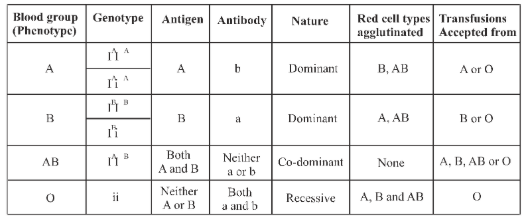
Both IA and IB are dominant over i, but not over each other. IA and IB show co-dominance between them producing AB blood group. Blood group 0 is produced when two recessive alleles (ii) are present. The ABO blood group is, therefore, an example of both multiple allelism and co-dominance.
Dihybrid Crosses
Such a cross in which two pairs of contrasting characters are taken into consideration simultaneously, is called dihybrid cross, e.g; cross between pea variety having yellow cotyledons and round (smooth) seeds with another variety having green cotyledons and wrinkled seeds.
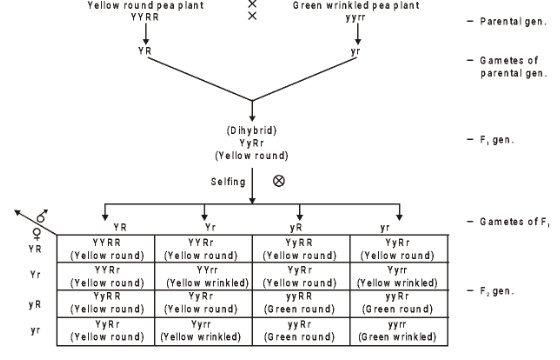
So in F2 generation of dihybrid cross :
Phenotypic ratio :9 : 3 : 3 : 1
[Yellow round][Yellow wrinkled][Green round][Green wrinkled]
Genotypic ratio:1 : 2 : 1:2 : 4 : 2 : 1 : 2 : 1
Conclusion drawn from a Dihybrid Cross
From the F2 generation of a dihybrid cross, Mendel concluded as under :–
Law of Independent Assortment (Postulate 4) : It states, “When two pairs of independent alleles are brought together in F1 hybrid, they show independent dominant effects, in the formation of gametes law of segregation occurs and the factors (genes) assort themselves independently, at random and freely.”
Inter-Genic Or Non-Allelic Gene Interactions
Complementary Genes (9:7 Ratio): If two dominant genes present on different loci produce the same effect when present alone but interact to form a new trait when present together, they are called complementary genes, or complementation between two genes for the production of a particular phenotype is regarded as complementary genes.
Example: Flower colour in Pea. Bateson and Punnet (1906) made a cross between two white flowered varieties of sweet pea (Lathyrus odoratus) in which F1 progeny was purple flowered. The flower colour in L. odoratus is determined by two dominant genes C and P. When purple individuals of F1 are self-pollinated, they produce purple and white in the ratio of 9:7. Bateson assumed that 9:7 is merely the modification of Mendelian F2 ratio 9:3:3:1 in which the last three classes (3:3:1) have the same phenotypic ratio. The two white varieties of L. odoratus have the genotype CCpp and ccPP.
Here dominant gene C produces an enzyme that catalyzes the formation of colourless chromagen. Dominant gene P produces an oxidase enzyme that oxidizes chromagen into purple coloured anthocyanin, and thus purple colour is produced. This is confirmed by mixing the extract of the two types of flowers when purple colour is formed. Therefore, at least one C gene and one P gene must be present to produce purple flowers. The absence of any one or both results in white flowers.
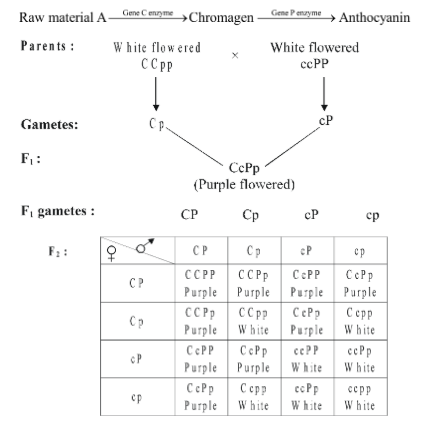
Phenotypic ratio = 9 purple : 7 white
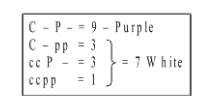
In Lathyrus odoratus, the complementary genes also show recessive epistasis. When either of the two genes in double recessive state (cc – , pp – , ccpp), the dominant allele of the other gene (cc P – , C – pp) is unable to express its effect. Consequently, the flower colour is white. When the epistatic effect is absent (C – P – ) the dominant alleles of both the genes become operational and produces purple colour of their joint activity.
Frequently Asked Questions
Inheritance is the transmission of genetic traits from parents to offspring.
Gregor Johann Mendel, who conducted experiments on pea plants.
- Law of Dominance – In heterozygotes, one allele (dominant) expresses itself while the other (recessive) is masked.
- Law of Segregation – Allele pairs separate during gamete formation and recombine at fertilization.
- Law of Independent Assortment – Genes for different traits assort independently during gamete formation.
A cross involving a single pair of contrasting traits (e.g., tall × dwarf pea plants). The F₂ ratio is 3:1 (phenotypic).
A cross involving two pairs of contrasting traits (e.g., seed color and shape in peas). The F₂ phenotypic ratio is 9:3:3:1.